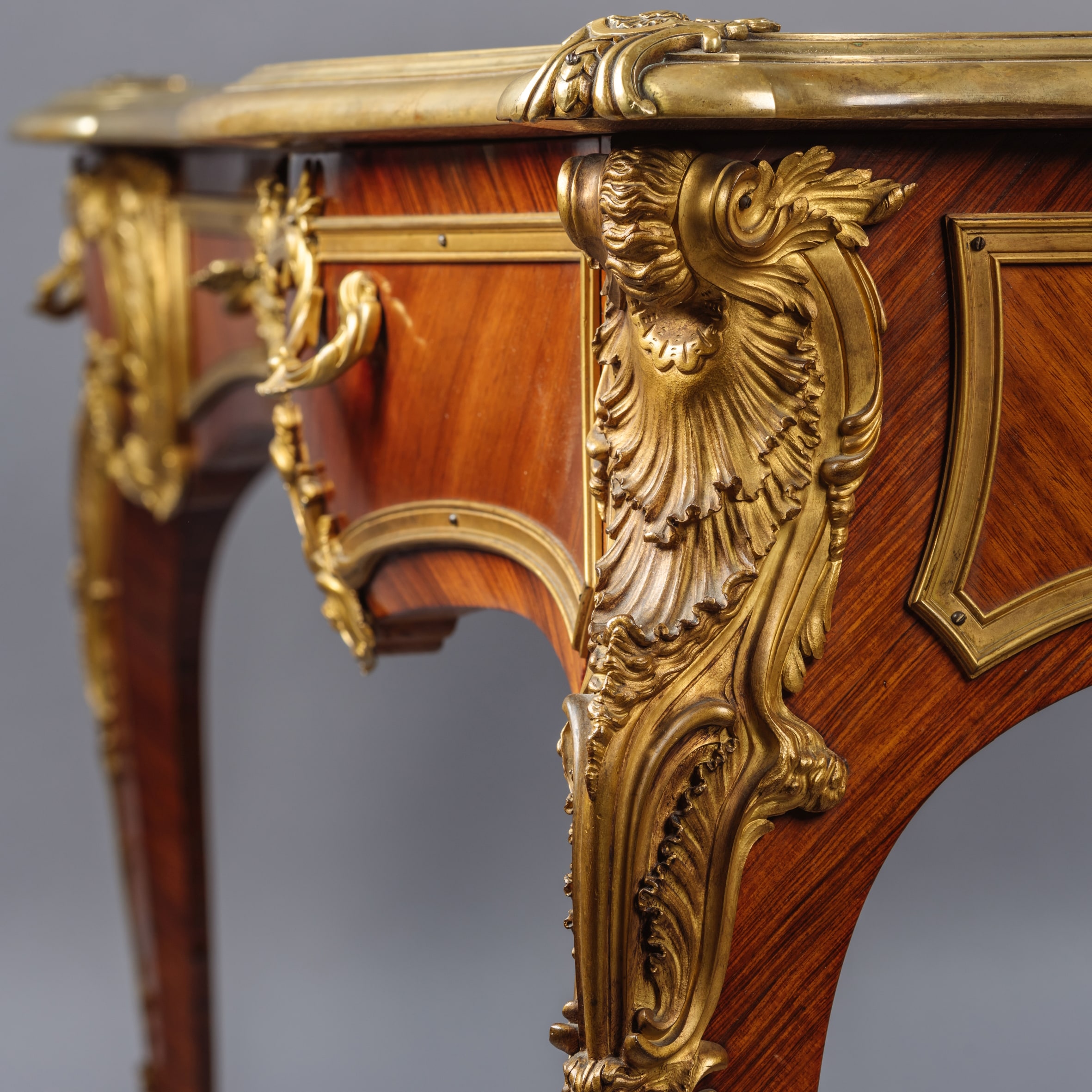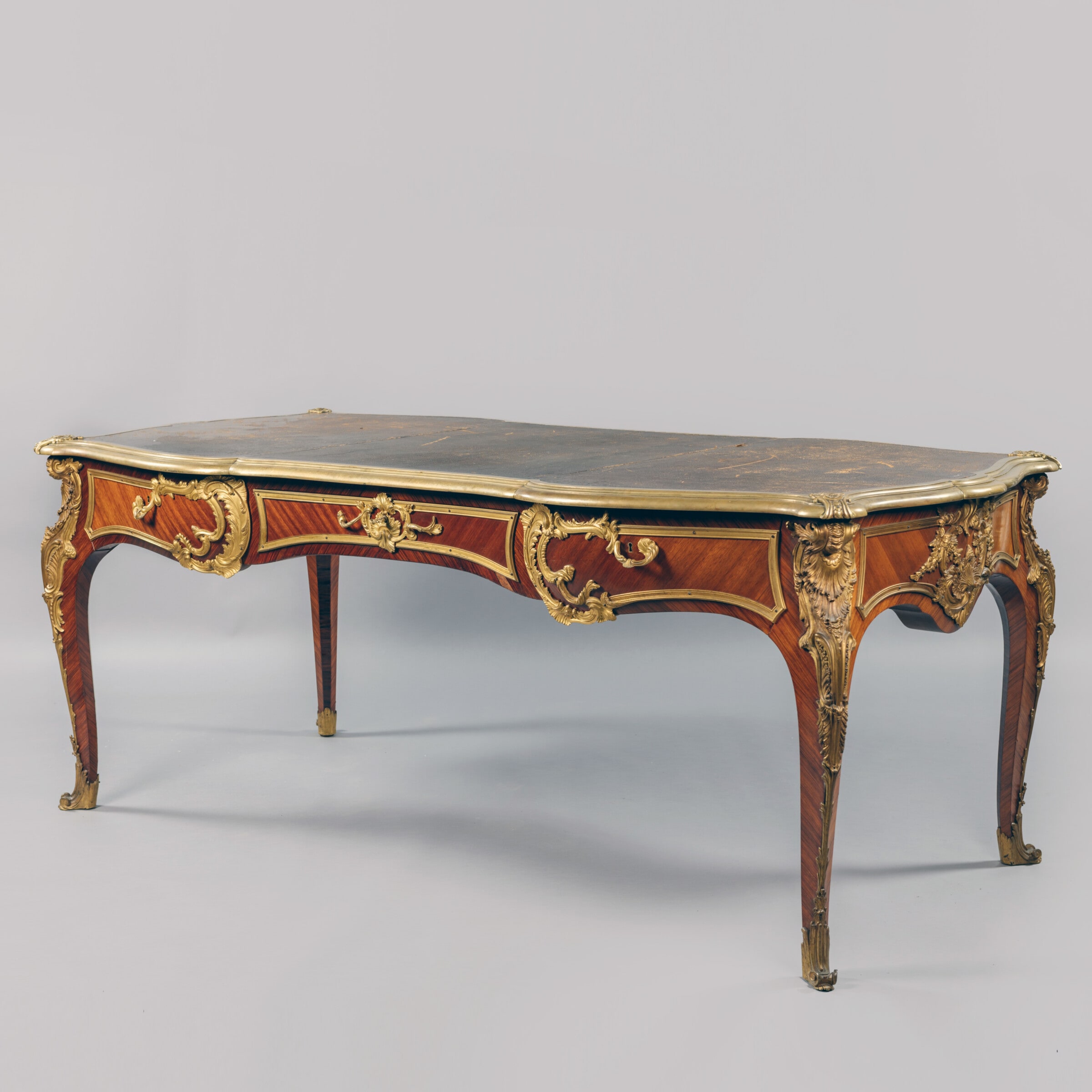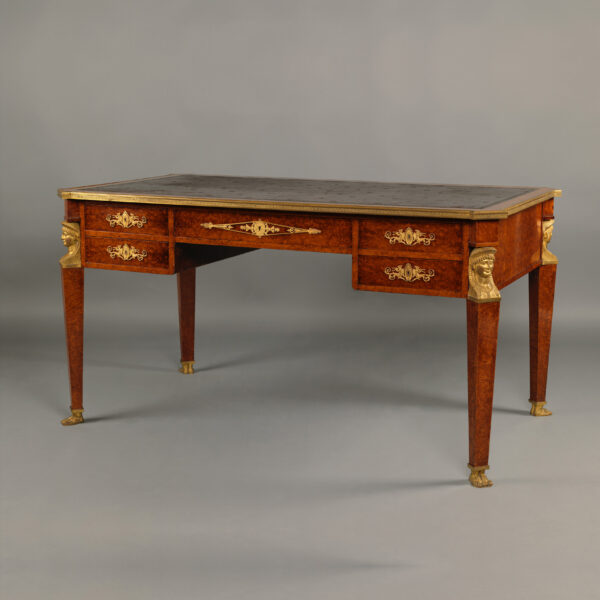Paul Sormani
Un fino buró de caoba de estilo Luis XVI montado en bronce dorado por Paul Sormani
£65,000
A Fine Louis XVI Style Gilt-Bronze Mounted Mahogany Bureau Plat, By Paul Sormani. Signed to the lockplate 'P. SORMANI PARIS / 10 rue Charlot'. This...
Dimensiones
Altura: 80 cm (32 in)Width: 190 cm (75 in)
Depth: 100 cm (40 in)
Descripción
A Fine Louis XVI Style Gilt-Bronze Mounted Mahogany Bureau Plat, By Paul Sormani.
Signed to the lockplate ‘P. SORMANI PARIS / 10 rue Charlot’.
This elegant bureau plat is superbly made. The gilt-bronze surround is gently curved to front and back and encloses a top set with three pieces of leather. The beautiful undulating shaped frieze is fronted with three drawers and three false drawers to the back. The acanthus and C-scroll drawer pulls are exuberantly cast, as are the robust shells to the angles which sit atop cabriole legs. The lightness and delicacy of the design belies the grand proportions.
This fine bureau plat is in good original unrestored condition. It is of good colour and has fine gilt-bronze mounts which would clean well but are currently a fine soft golden aged colour.
Francés, Circa 1870.
The palatial bureau plat by the famous maker Paul Sormani dates to Circa 1870. It revives a famous Louis XV period model known as the ‘bureau de l’abbé Terray’, which was presumably available to be admired and viewed from the mid-19th century as versions after this date are recorded by Alfred Beurdeley Henry Dasson, Gervais Durand and Antoine Krieger – as well as by Paul Sormani. No doubt the design was so popular in the 19th century because it embodies the sinuous forms of the rococo whilst retaining elegant and delicate proportions.
The ‘bureau de l’abbé Terray’ is stamped by Nicolas Pierre Séverin (1728 – 1798) and entered the collection of the musée du Louvre in 1924 (inv. OA7805). Another period writing table of this model is today in the Getty Museum (71.DA.95). That example is attributed to Joseph Baumhauer and is thought to have been given by Louis XV to the Empress of Russia in 1745 and sold by the Soviet government in 1931 to Duveen Brothers who in turn sold it to Anna Thomson Dodge, delivered in 1934.
Fecha
Alrededor de 1870
Origen
Francia
Medio
Gilt-Bronze
Firma
Signed to the lockplate 'P. SORMANI PARIS / 10 rue Charlot'
Born in Venice in 1817, Paul Sormani (1817-1877), was a Parisian maker of fine ‘meubles de luxe’. His work was described in the catalogue of the 1867 Exposition Universelle as: ‘toute sa production révèle une qualité d’exécution de tout premier ordre’ (all of his production reveals a quality of execution all of the first order’).
Sormani exhibited at the International Exhibitions in Paris in 1849, 1855, 1867, 1878 and 1900, and in London in 1862, winning numerous medals.
Paul Sormani established the firm in 1847 at 7 Cimetière Saint-Nicolas in Paris, moving in 1854 to 114 rue du Temple, and in 1867 to 10 rue Charlot.
After his death in 1877 Sormani’s son Paul-Charles took over the business that later moved to 134 Boulevard Haussmann.
It can be difficult to date Sormani’s work, as the firm produced furniture for nearly ninety years. However, when Paul Sormani died in 1877, his wife and son took over the business and from this date onwards pieces are normally signed ‘Veuve Sormani & Fils’.
Bibliografía:
Mestdagh, Camille & Lécoules, Pierre. L'Ameublement d'art français : 1850-1900, Les Editions de l'Amateur, (París), 2010.
Meyer, Jonathan. Great Exhibitions – London, New York, Paris, Philadelphia, 1851-1900, Antique Collectors’ Club, (Woodbridge, UK), 2006.
Ledoux – Lebard, Denise. Les Ébénistes du XIXe siècle, Les Editions de L’Amateur, (Paris), 1984; pp. 583-588.















 Imprimir
Imprimir


